How to Grow Radishes
This post may contain affiliate links, which means that I may receive a commission if you make a purchase using these links. As an Amazon Associate I earn from qualifying purchases.
Radishes are quick-growing root vegetables ready in just 30 days after planting. These tips will show you how to grow radishes in the garden, in containers, and even indoors.
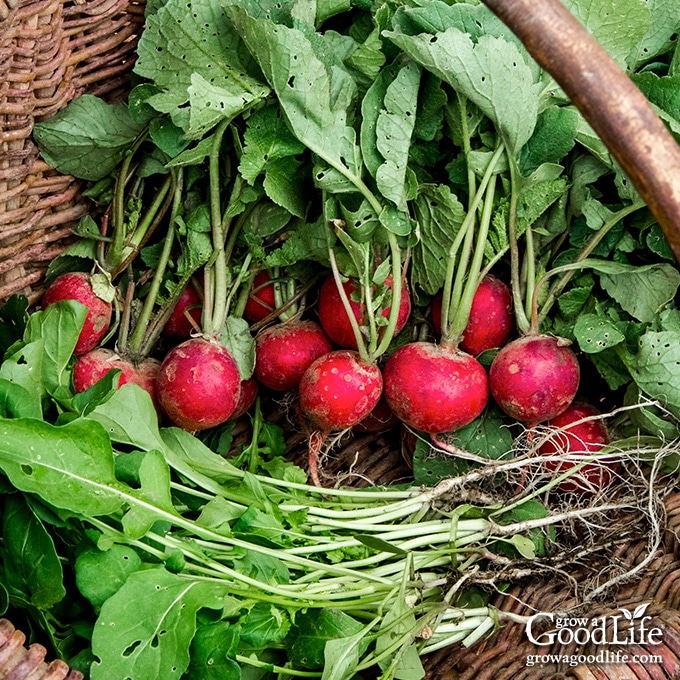
The first spring salad made with homegrown garden harvests is not complete without the peppery crunchiness of sliced radishes.
Radishes are one of the fastest maturing vegetables that you can grow. They go from seed to harvest in just four weeks. Radishes grow equally well when planted in the garden, in containers, in raised beds, or even indoors under lights as long as they have at least 6-inches of soil under the seeds.
Radishes are a tasty snack when eaten raw, add a peppery crunchiness to salads, and are delicious roasted, which mellows their spicy flavor. The greens are also edible and can be sautéed with garlic, pureed into pesto, tossed into salads, and give soups a mild peppery taste.
About Radishes
Radishes (Raphanus sativus) are a member of the Brassicaceae family closely related to mustard and cabbage. They are a cool-season vegetable that produces edible bulbous roots and green tops packed with nutrition. All parts of the plant, including the bulbs, greens, flowers, and seedpods, are edible.
The root is naturally low in calories, high in fiber, and rich in calcium, iron, riboflavin, vitamin B6, potassium, copper, and manganese. The green tops contain powerful antioxidants and are rich in vitamin C and calcium.
Radish Varieties to Consider Growing
With so many colors, shapes, and various levels of spiciness, you are sure to find a favorite or two in the bunch. There are even varieties that you can grow in fall for winter food storage.
The most common garden radish variety is the small, round, red-skinned ones with white flesh. But some types are long, cylindrical, or tapered, much like a carrot. They can be bright scarlet, pink, purple, or white, while the inside flesh can be purple, white, pink like a watermelon, or greenish-yellow.
Spring Radishes
Spring radishes, also called garden radishes, grow best in cool weather, and a few can tolerate a little summer heat as long as they receive plenty of water. Spring radishes mature quickly, often within 20 to 30 days. Recommended garden radishes for early spring and fall planting include:
- Champion radishes produce 2-inch round, deep red-colored roots with firm white, crisp flesh. They grow fast and don’t become pithy even when experiencing a little heat.
- Cherry Belle is a Holland heirloom variety with uniform round roots, deep red skin, white flesh, and a mild, crispy texture.
- Early Scarlet Globe is a traditional round red-skinned radish with crunchy white flesh and a mild spicy flavor. This variety can tolerate warm weather better than many as long as it gets plenty of water.
- Easter Egg, also called Rainbow, is a mix of radish varieties to achieve a rainbow of colors ranging from deep purples to reds to pinks and whites.
- French Breakfast is an old-fashioned French heirloom with oblong-shaped deep pink roots with a white tip. It can take some summer heat, and the flavor is less bitter than other varieties when harvested young.
- Purple Plum radishes have beautiful vibrant purple skin, white flesh, and a mild sweet flavor. They are a little slower to mature, up to 30 days, but this variety can tolerate warmer temperatures without getting pithy.
- Sparkler radishes have scarlet and white round roots, with white flesh that tastes very spicy. They grow quickly, maturing into 1-inch roots within 20 days.
- White Icicle is an heirloom radish variety that goes by many names, including Icicle Short Top, White Italian, and Long White. It grows long, slender white roots that look like a white carrot. The flesh is tender and crisp with a rich and spicy flavor. Established plants can tolerate warmer temperatures.
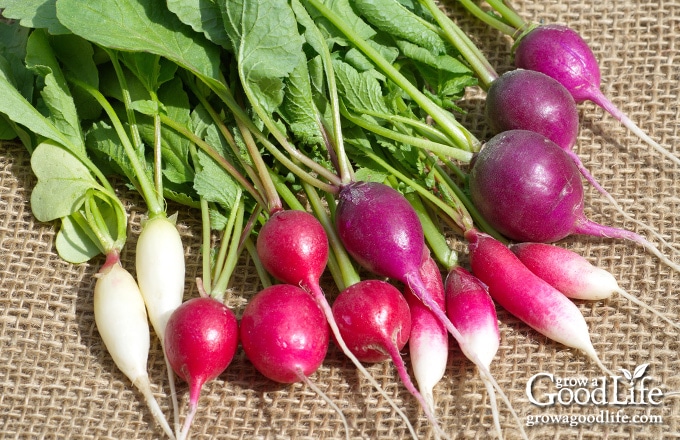
Winter Radishes
Winter radishes, also called Asian radishes or Daikon radishes, grow larger roots that are slower to mature, contain more starch, and taste less spicy than the spring varieties. Plant winter radishes in late summer, so they grow during the cool weather of fall, and you can harvest them before the ground freezes. Depending on the type, winter radishes mature in 50 to 60 days.
You can store winter radishes like other fall harvested root vegetables in a cool area or root cellar for up to several months. Winter radish varieties include:
- Black Spanish, also known as Noir Gros Rond d’Hiver, is a large round radish with rough-textured jet-black skin and a smooth white interior. The roots are 3 to 4 inches in diameter, and the flavor is powerfully spicy, but the heat is tamed when cooked.
- China Rose radish grows long tapered rosy red-colored roots that can reach up to 5-inches long.
- Daikon radishes are the largest winter radishes, with long white roots resembling a carrot. Some can grow up to 15 inches in length and 3 inches in diameter! They have crisp flesh with a mildly sweet and peppery flavor.
- Green Meat Daikon has a long tubular-shaped root with green and white skin. The white flesh is milder and slightly sweet in flavor compared to other varieties.
- Purple Daikon radishes are almost too pretty to eat. The roots are oval-shaped with purple skin. The flesh is white with beautiful purple streaks throughout. They have a slightly sweet and mild peppery flavor.
- Schwarzer Runder, also known as Munich beer or black winter radish, is a German heirloom with large 1 to 2-inch round roots, black skin, snow-white flesh, and a crisp, spicy flavor.
- Watermelon, also called Red Meat, and Beauty Heart radishes, grow 2 to 3-inch ball-shaped roots with light green and white skin and magenta and white centers that look like a watermelon when sliced.
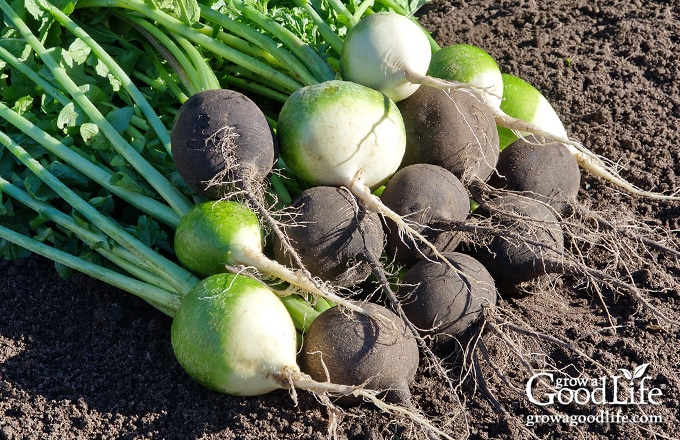
Tips for Growing Radishes
While radishes are often considered an easy-to-grow vegetable for beginners, some tips will help you grow a bountiful crop.
When to Plant Radishes
Radishes are cool-season vegetables that tolerate light frosts and grow best in the cool weather of spring and fall in the north. However, if you garden in the south, you can grow radishes as a winter crop as long as the ground isn’t frozen.
The time to start your seeds will depend on your last frost date for spring radishes and the estimated first freeze for winter varieties. You can find your estimated frost dates by contacting your local extension office or entering your zip code here at PlantMaps.com.
- Spring Radishes: You may begin sowing garden radish seeds in early spring after the danger of heavy frost is past and once the soil has drained and warmed to at least 40˚F. Succession sow seeds every two weeks for a continuous harvest until summer weather hits. Begin planting again once the temperatures cool in fall, and succession, plant until the ground freezes.
- Winter Radishes require a decreased day length, cool temperatures, and a much longer growing period. Sow winter varieties in late summer to early fall, giving them enough time to mature before the ground freezes. In my zone 5 garden, I sow winter radishes in August and harvest in September through October.
How to Prepare the Garden Bed
Radishes grow best in full sun or partial shade. In early spring, choose a planting location that receives full sun. When planting in late spring or early summer, select an area that receives morning sun and partial shade in the afternoon to protect the plants from intense heat.
Radishes prefer well-draining soil but will tolerate a wide range of soil types. Before sowing seeds, prepare your garden beds by removing weeds and stones. Next, add 2-inches of compost on top of the soil and work it down to the depth of 4-inches.
If the weather has been dry, give the beds a good watering the day before you plan on sowing your seeds.
Radishes are not heavy feeders, and some good quality compost at planting time is all you need to nourish the plants, prevent soil compaction, and promote good drainage.
Sowing Radish Seeds
Radish seedlings have a long taproot and rarely survive when transplanted. They also grow so fast that it’s unnecessary to start them indoors early. Direct sow the seeds in the location you want them to grow.
Sow seeds 1/2-inch deep in prepared soil, spacing them about 1-inch apart for garden varieties and 4-inches apart for daikon winter radishes.
Lightly cover with soil, water gently, and keep the soil evenly moist until the seeds sprout and become established. You can learn more about direct sowing seeds in this article: How to Direct Sow Seeds in the Garden
The seeds will sprout in 7 to 10 days, depending on the variety and soil temperature. The best germination rate occurs when the soil temperature is between 55 and 85˚F.
Sow another round of radish seeds every 2 weeks for a continuous harvest until the weather warms. Then, begin sowing radishes again in late summer for fall harvests starting about 10 weeks before your first fall frost date. Succession sow every 2 weeks up to your area’s last expected frost date.
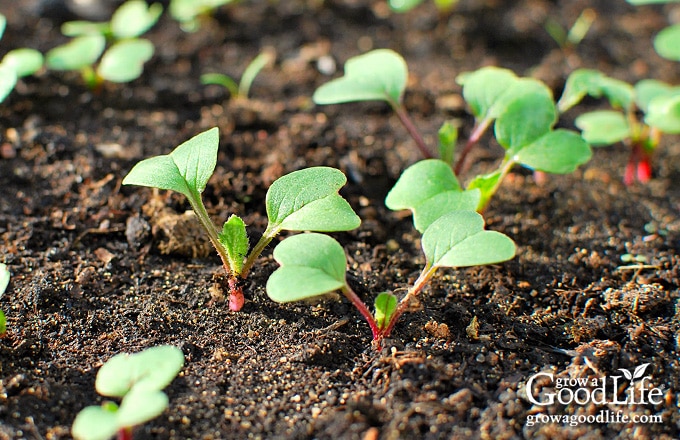
Radish seeds have a very long shelf life and are viable for over 5 years if stored properly. If you have old seeds, go ahead and plant them. There may be a reduction in germination, but you will know in a few days if the seeds are viable.
How to Care for Radishes
Once planted, radishes are easy to care for, but there are a few things you need to know to help the plants grow healthy:
Watering
Radish plants should receive about 1-inch of water per week from rain or hand watering to ensure proper bulb development. First, check the soil moisture by poking your finger several inches deep. If the soil is dry, give the plants a good watering and let the water soak in deeply to reach the roots.
Moisture fluctuations can stunt growth and trigger the roots to crack. If you are not getting enough rain, hand water once a week for heavy soils and twice a week for sandy soils to help keep the soil evenly damp.
Thinning the Plants
Once the plants are 3-inches tall, thin to 4-inches apart for spring radishes, and 6-inches for winter varieties. Damp soil will help the roots slide out easier and reduce the risk of disrupting the other plants.
Radishes will not grow well if crowded. Even though it’s so hard to pluck those seedlings out of the soil, go ahead and do it so the remaining plants will be productive. The thinned-out plants are edible. Add them to a leafy green salad, soup, or stir-fry recipe.
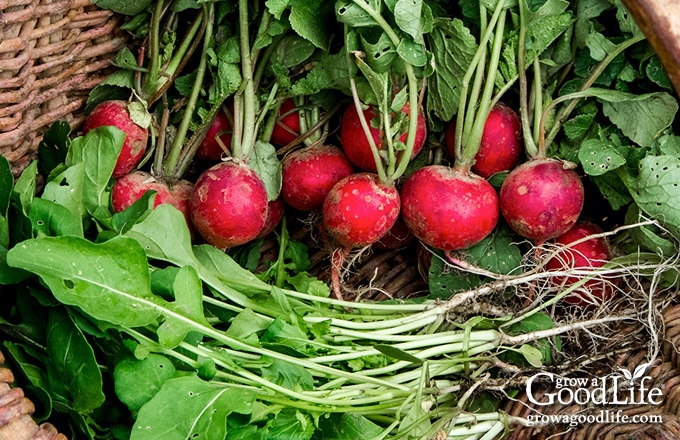
Mulching the Soil
Once the radish seeds are several inches tall, add a layer of mulch on the soil surface while keeping it a few inches away from the stems of your seedlings, so it doesn’t smother the plants.
A light layer of mulch will help retain moisture and keep the soil cooler. Use straw, shredded newspaper, or pine needles. Learn more about how organic mulch helps your garden.
Keeping Up with the Weeds
Since the radishes grow so fast, weeds are typically not a big problem. By the time a weed seed has germinated, it’s usually time to harvest the radishes. If a weed pops up, pluck it out of the soil and discard it.
Troubleshooting Growing Problems
Radishes are a great vegetable to grow and seldom have problems, but here are a few issues you may come across:
Soil Crusting
Heavy rain can create a hard crust on top of the soil preventing germinated seeds from breaking through. You can soften the hard top crust of soil by gently watering it. A light sprinkle of chopped straw also helps prevent the soil from compacting.
Lots of Greens, but No Bulbs
Radishes fail to form bulbs for several reasons, including crowding, too much nitrogen, and temperatures too warm.
Space the seeds properly when planting, and thin the plants to give them plenty of room to grow and form roots. Avoid over-fertilizing the plants. Radishes do not need additional fertilizer other than a little finished compost at planting time. Radishes will also not bulb properly during temperatures above 80˚F. Therefore, grow radishes in cool temperatures in spring and fall.
Bolting or Going to Seed
Radishes will bolt or go to seed if the soil dries out or once the temperature warms. When this happens, you will see a tall flower stalk emerging from the center of the plant. The stem will grow several feet and then bloom.
After the plants bolt, the bulbs are too tough and pungent to eat. So either pull the plants or leave the flowers for pollinators. Eventually, the flowers will develop seed pods that look similar to beans.
The seed pods are edible. You can harvest and use them as you would snow peas. If you leave the seeds on the plant to dry, you can save some of the seeds for the next crop.
Common Pests
Aphids, caterpillars, flea beetles, grasshoppers, leaf miners, slugs, and other insects may chew on the foliage. Cut and destroy affected vegetation, discard damaged roots, and control weeds to keep the population down. Protecting the plants with a floating row cover right after the seeds germinate can control most flying pests.
Root maggots, wireworms, weevils, and voles can damage the roots beneath the ground. Most cause minor damage. To reduce problems, maintain healthy soil, practice good sanitation, rotate your crops, and turn the soil to expose the pests to birds or chickens to help keep the population down. Some believe that mulching with wood ash deters maggots.
Growing Radishes in Containers
Growing radishes in pots allow you to move the containers to the perfect location to receive the morning sun. Choose a container that is at least 6-inches deep with plenty of drainage holes in the bottom to allow excess water to drain away quickly.
Use a good quality potting mix suitable for growing vegetables in containers. First, sift the soil mix to remove chunks and wood chips. Next, add a garden trowel full of compost to each container, combine well, and then hydrate the soil by letting it soak for several hours. Fill the pot once the soil is evenly damp.
Sow the seeds, cover them with soil, firm in gently, and water in well. Keep the soil evenly moist until the seeds sprout and the plants become established. Then let the soil dry out a bit in between, watering only when the top inch of soil is dry.
Thin to about 4-inches apart once the plants are 3-inches tall, harvest once the roots reach a usable size, and sow more seeds every 2 weeks.
Growing Radishes Indoors
Growing radishes indoors in containers on a sunny windowsill or under grow lights is a great way to have a steady supply of roots and greens all year. A medium-sized, window box container that is about 6-inches deep will grow plenty of radishes.
Fill the pot with a damp potting mix suitable for containers. Mix in a balanced slow-release organic fertilizer, and sow your seeds. Water the plants regularly, thin as needed, and wait until the roots are big enough to harvest.
Using Radishes as a Cover Crop
The radish is small, but it’s a mighty significant contributor to the health of a home garden. In addition to providing two highly nutritious vegetables in one spot, you can use radishes to improve the garden soil structure.
As a root vegetable, its downward growth habit loosens the soil and prevents compaction. Rainwater and air can circulate better in the soil, making it attractive to earthworms and other soil organisms. The earthworms help break down and recycle the organic material in the soil, leaving behind their casting to increase soil fertility. Learn more about building healthy garden soil.
If you are looking for a cover crop for a large area, you’ll find Cover Crop Radishes or Tilling Radishes are sold by the pound.

Companion Planting Radishes
Since radishes mature so quickly, they make the ideal crop to companion plant with other vegetables. Interplanting radishes with other slower-growing crops makes good use of garden space. The radishes have plenty of time to grow and harvest before the other plants need the area.
Radishes help repel cucumber beetles, so consider planting radishes with zucchini, pumpkins, cucumbers, melons, and other squash.
Sowing radish and carrot seeds together help prevent the soil from crusting. The radish seeds sprout first, and the roots expand quickly, preventing the soil from crusting and obstructing carrot germination.
Radishes can be used as a trap crop for flea beetles. Plant a row of radishes away from other brassicas, such as broccoli, cabbage, cauliflower, and kale, to draw the pests away from young seedlings.
Other good companion plants for radishes include beans, beets, eggplant, lettuce, onions, peas, parsnips, peppers, spinach, tomatoes, tomatillos, and herbs like chervil, dill, mint, oregano, and rosemary. The radishes will mature before most other crops and help break up the soil as they grow.
When and How to Harvest
You can harvest garden radishes at any stage of development. To harvest, gently scratch the soil away from the plant, grasp the base of the stem, and lift upwards.
Wash thoroughly to remove all soil, remove the greens from the roots and store them separately. Spring varieties of radishes will keep in the refrigerator for about a week or two before they shrivel and lose their crunchy texture and flavor. The greens will last in the fridge for two to three days and are delicious tossed into salads, sautéed, and added to stir-fry.
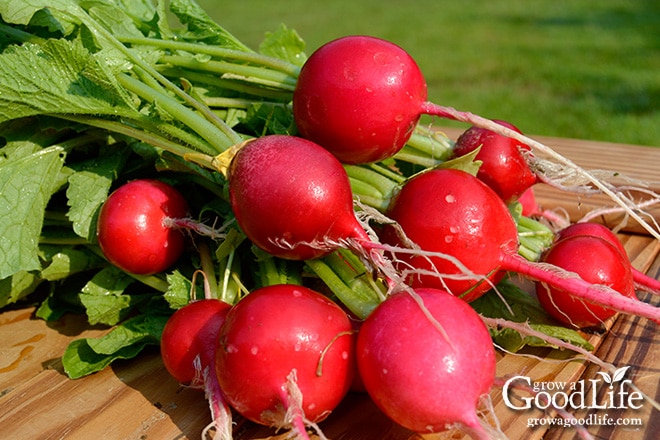
Daikon and many other winter radishes will push themselves out of the soil and show their shoulders when they are ready to be harvested. However, since these radish varieties grow deep into the ground, they will need a little digging to harvest.
The width of the root will be evident from the shoulders that are above the soil level. Use a garden trowel and dig underneath the daikon so you can harvest the long roots without breaking them. Wash, remove the greens and store them separately in the refrigerator.
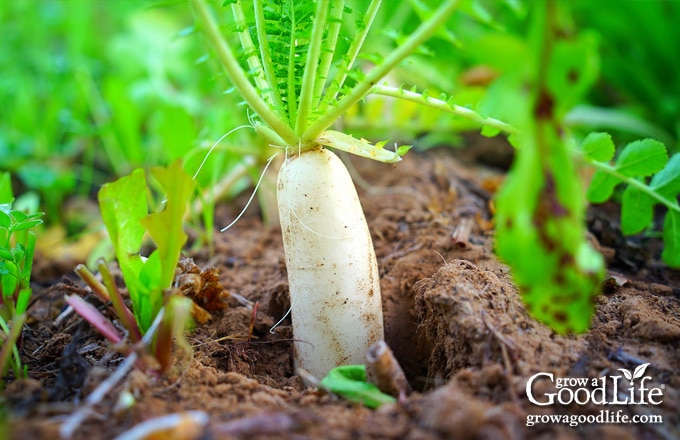
Ways to Enjoy Radishes
While spring radishes are often eaten raw on sandwiches, salads, or on a vegetable platter with dip, winter radishes are usually roasted, simmered in stews, and grilled.
Use the radish greens in the same way as spinach, chard, and kale, such as by adding raw to a fresh green salad, simmering in soups, or sautéing with olive oil and garlic.
Radish seed pods have a mild, peppery flavor and can be used in salads, stir-frys, and soups. You can also pickle radish seed pods. Follow this recipe for refrigerator pickles.
Storing Winter Radishes
Winter radishes can last 3 months when stored in a cool, moist environment such as a root cellar or basement.
To store winter radishes:
- Fill a box, bucket, or tote with 3-inches of moist sand or sawdust.
- Trim the tops off the radishes, and layer the roots on the sand.
- Top with more sand, add another layer of radishes and continue until the container is full or you run out of radishes.
- Store the bucket in a cool area and frequently check for signs of spoiling. The ideal storage condition is at a temperature of 32 to 35˚F and 90% relative humidity.
—
As you can see, radishes have many good things to offer and should have a place in every vegetable garden. Following these tips, you can grow this rewarding and nutritious vegetable in your garden, in containers, or indoors.
You May Also Like:
- Growing Radish Microgreens
- Low Maintenance Gardening Tips
- Using Crop Rotation for Healthy Plants
- Quick Growing Crops for Fall
Good planning is key to a successful vegetable garden
Whether you are new to growing your own food or have been growing a vegetable garden for years, you will benefit from some planning each year. You will find everything you need to organize and plan your vegetable garden in my PDF eBook, Grow a Good Life Guide to Planning Your Vegetable Garden.

